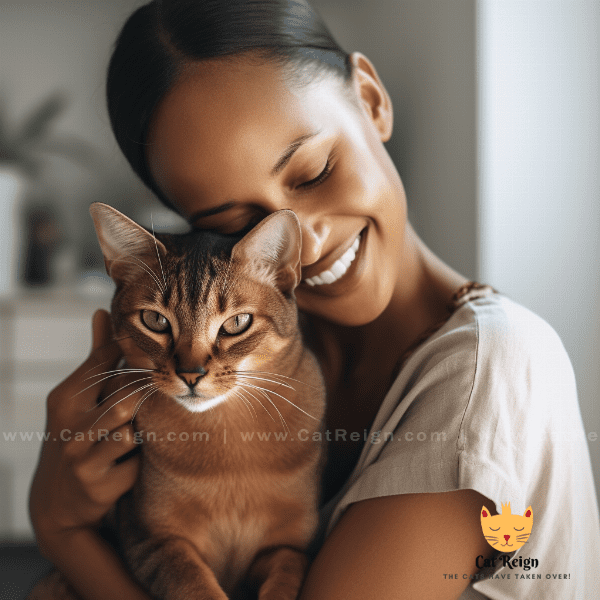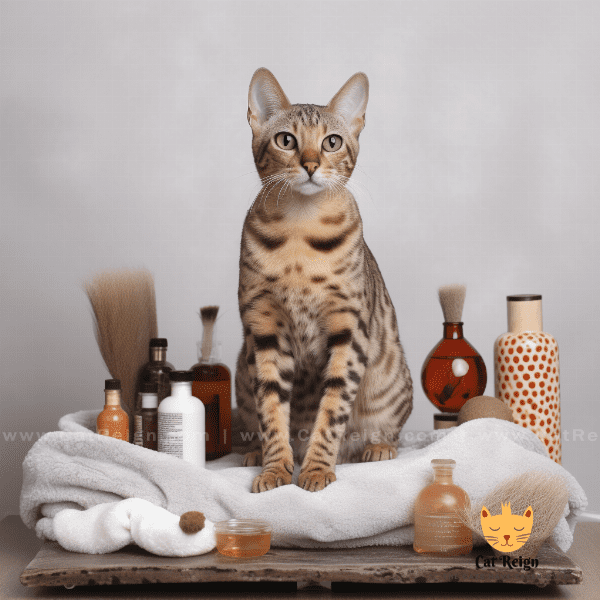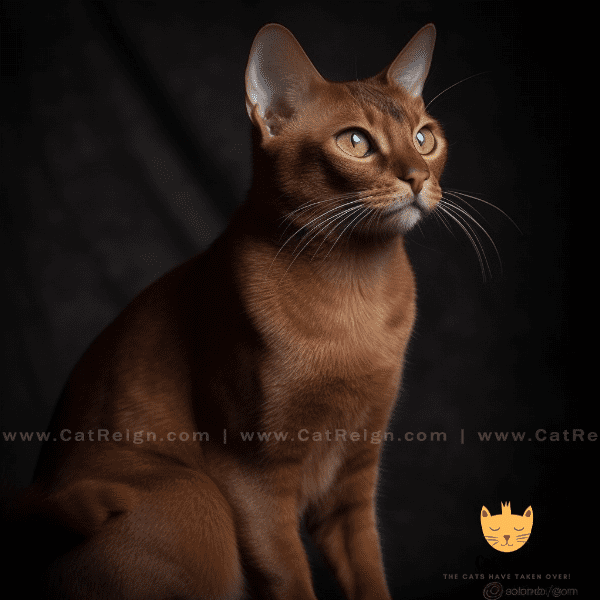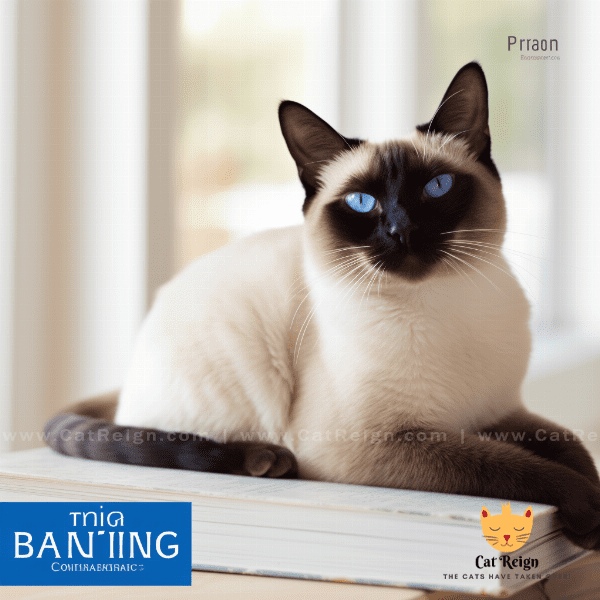Table of Contents
- Origins and History of the Abyssinian Cat
- Physical Characteristics of the Abyssinian Cat
- Abyssinian Cat Personality Traits
- Training and Care for Your Abyssinian Cat
- Health Issues Common in Abyssinian Cats
- Abyssinian Cats in Pop Culture and Literature
- Abyssinian Cat Breeding and Genetics
- The Abyssinian Cat in Society and Culture
- Interacting with Your Abyssinian Cat: Tips and Tricks
Origins and History of the Abyssinian Cat
The Abyssinian cat, also known as the Aby cat, is an ancient breed of domestic cat with a fascinating history. While the breed’s exact origin is unknown, there are several theories about where it comes from.
Theories on the Origins of the Abyssinian Cat
One popular theory is that the Abyssinian cat is descended from the cats worshipped by the ancient Egyptians. It’s believed that these cats were brought to Europe by soldiers returning from Egypt, where they were then bred with other cats to create the modern-day Abyssinian.
Another theory suggests that the breed is native to Abyssinia, which is now known as Ethiopia. In the 1860s, an Abyssinian cat was brought to England from Ethiopia by a British soldier, and it was this cat that became the foundation of the modern-day Abyssinian breed.
Popularity of the Abyssinian Cat
The Abyssinian cat has been a popular breed since the early 20th century. In fact, it was one of the first breeds recognized by the Cat Fanciers’ Association (CFA) in the United States, which is the largest registry of pedigreed cats in the world.
Today, the Abyssinian is still a popular breed among cat lovers, known for its distinctive ticked coat, intelligence, and playful personality.
Unique Characteristics of the Abyssinian Cat
In addition to their unique coat, Abyssinian cats are known for their high energy and playful personalities. They are also intelligent cats and can be easily trained to perform tricks or to use a litter box.
In conclusion, the Abyssinian cat is a breed with a rich history and unique characteristics that set it apart from other breeds. Whether you’re a longtime Aby owner or just learning about the breed, there’s no denying the charm and appeal of these fascinating felines.

Physical Characteristics of the Abyssinian Cat
The Abyssinian cat is a medium-sized cat with a muscular build and a distinctive ticked coat. In this section, we’ll take a closer look at some of the physical characteristics that make the Abyssinian cat unique.
Body Type and Build
The Abyssinian cat is a muscular and athletic breed, with a long and slender body. They have strong legs and well-defined muscles, which give them the ability to jump high and run fast. Their paws are small and oval-shaped, with tufts of hair on the tips.
Coat and Color
One of the most distinctive features of the Abyssinian cat is its coat. The breed has a short, dense coat with a unique ticking pattern that gives the fur a shimmering appearance. The fur is soft to the touch and has a lustrous quality. Abyssinian cats come in a variety of colors, including ruddy, red, blue, and fawn.
Facial Features
The Abyssinian cat has a wedge-shaped head with large, expressive eyes that are typically green or gold. Their ears are large and pointed, and they have a prominent nose that adds to their distinctive look.
Tail and Other Characteristics
The Abyssinian cat has a long, slender tail that tapers to a point. They are also known for their vocalizations, which include a distinctive purr and a meow that is often described as a chirp or trill.
In conclusion, the Abyssinian cat has several physical characteristics that make it a unique and striking breed. From their muscular build to their distinctive ticked coat and expressive facial features, Abyssinians are a breed that is sure to turn heads and capture hearts.
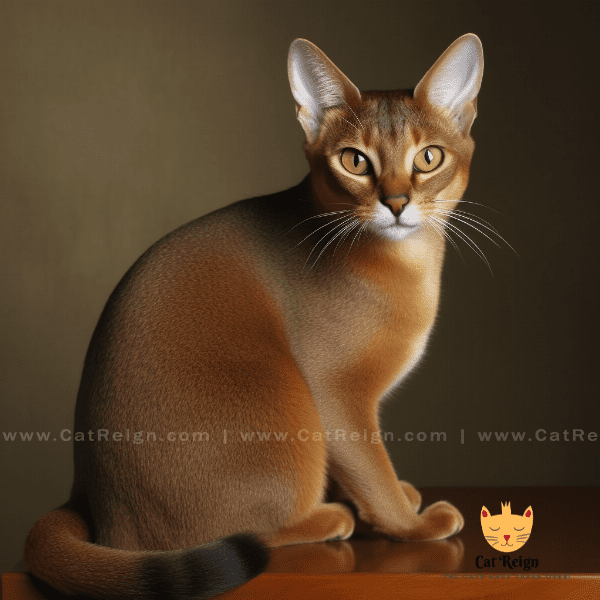
Abyssinian Cat Personality Traits
The Abyssinian cat is known for its high energy, intelligence, and affectionate nature. In this section, we’ll take a closer look at some of the personality traits that make the Abyssinian cat a beloved breed.
Affectionate and Loyal
Abyssinian cats are known for their affectionate nature and their strong bonds with their owners. They crave attention and love to be near their human companions. They are also a loyal breed, and once they form a bond with their owner, they will be devoted for life.
Active and Playful
Abyssinian cats are a highly active breed and love to play. They are known for their love of toys, and will often play fetch or chase after objects for hours on end. They also have a love of climbing and are known for their ability to scale even the tallest of furniture.
Intelligent and Inquisitive
Abyssinian cats are a highly intelligent breed, and their curious nature makes them great problem solvers. They love to explore their surroundings and are known for their ability to open doors and cabinets. They also have a great memory and can quickly learn routines and habits.
Independent
While Abyssinian cats love attention, they are also an independent breed. They are self-sufficient and do not require constant attention from their owners. They are happy to spend time alone, as long as they have plenty of toys and stimulation to keep them entertained.
In conclusion, the Abyssinian cat is a breed with a unique personality that makes it a favorite among cat lovers. Their affectionate and loyal nature, combined with their high energy and intelligence, make them a wonderful addition to any household.
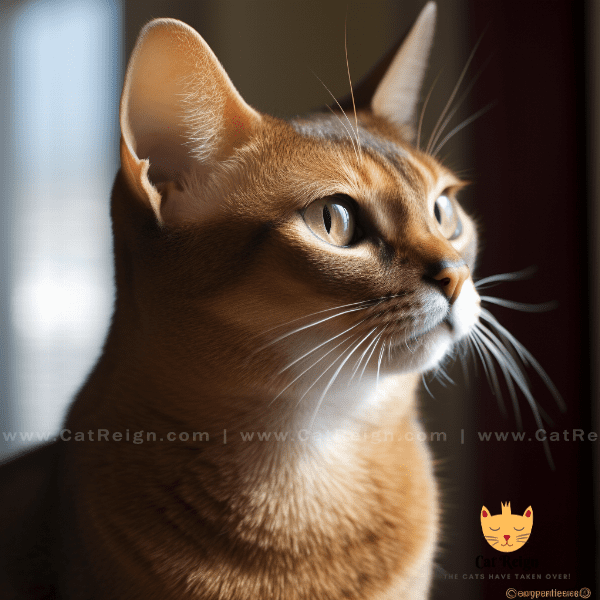
Training and Care for Your Abyssinian Cat
Litter Box Training
Litter box training is an important part of caring for your Abyssinian cat. It’s important to provide a clean and comfortable litter box that is easily accessible to your cat. Show your cat where the litter box is located, and encourage them to use it by placing them in the box after meals and when they wake up from a nap.
Exercise and Playtime
Abyssinian cats are a highly active breed, and regular exercise and playtime are essential for their physical and mental health. Provide your cat with plenty of toys to play with, and make time for interactive playtime every day. Consider providing climbing structures or a cat tree to satisfy their need to climb and explore.
Veterinary Care
Regular veterinary care is essential for maintaining your Abyssinian cat’s health. Schedule annual check-ups with your veterinarian, and make sure your cat is up-to-date on all necessary vaccinations. Look out for any signs of illness, such as changes in appetite or behavior, and seek veterinary care immediately if you have any concerns.
Training and Socialization
Abyssinian cats are highly intelligent and can be trained to perform a variety of tricks and behaviors. Positive reinforcement training techniques, such as clicker training, can be highly effective for training your cat. Socialization is also important for your cat’s well-being, so make sure to expose them to new people and experiences in a safe and controlled environment.
In conclusion, caring for your Abyssinian cat involves providing them with plenty of love, attention, and physical and mental stimulation. By following these tips and guidelines, you can ensure that your cat lives a happy and healthy life.

Health Issues Common in Abyssinian Cats
Like all breeds, Abyssinian cats are prone to certain health issues. In this section, we’ll take a closer look at some of the health problems that are common in Abyssinian cats.
Dental Issues
Abyssinian cats are prone to dental issues, such as periodontal disease and tooth decay. It’s important to provide your cat with regular dental care, such as brushing their teeth or providing dental treats, to prevent these problems from developing.
Renal Disease
Renal disease, or kidney disease, is a common health problem in Abyssinian cats. Symptoms of renal disease can include increased thirst, decreased appetite, and weight loss. Regular veterinary check-ups and blood work can help to detect and manage renal disease in its early stages.
Hyperthyroidism
Hyperthyroidism is a condition that occurs when the thyroid gland produces too much thyroid hormone. Symptoms of hyperthyroidism in Abyssinian cats can include weight loss, increased appetite, and hyperactivity. Treatment for hyperthyroidism can include medication, dietary changes, or in severe cases, surgery.
Patellar Luxation
Patellar luxation is a condition that occurs when the kneecap dislocates from its normal position. Abyssinian cats are prone to patellar luxation, which can cause pain and discomfort. Treatment for patellar luxation may include surgery or physical therapy.
Allergies
Abyssinian cats can be prone to allergies, which can cause skin irritation, itching, and inflammation. Common allergens include pollen, dust, and certain foods. If you suspect that your cat has allergies, consult with your veterinarian to determine the best course of treatment.
In conclusion, Abyssinian cats are prone to certain health issues, but with proper care and veterinary attention, many of these problems can be managed or prevented. Regular check-ups with your veterinarian and maintaining good dental hygiene are important steps in keeping your Abyssinian cat healthy and happy.
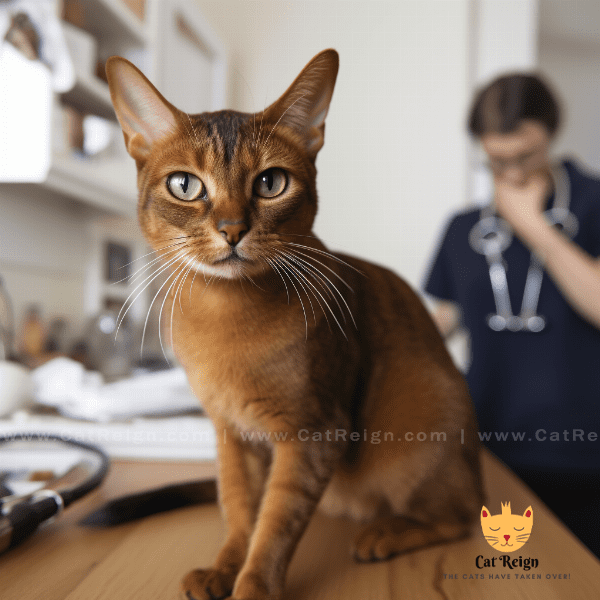
Abyssinian Cats in Pop Culture and Literature
Abyssinian cats have a long and storied history, and they have made appearances in popular culture and literature throughout the years. In this section, we’ll take a closer look at some of the ways that Abyssinian cats have been featured in pop culture and literature.
The Cat Who… Series
The Cat Who… series of mystery novels by Lilian Jackson Braun features a Siamese cat named Koko, who helps solve crimes alongside his owner, Jim Qwilleran. In later books in the series, Koko is joined by a female Abyssinian cat named Yum Yum, who is just as intelligent and curious as Koko.
Disney’s The Aristocats
Disney’s 1970 animated film The Aristocats features a group of sophisticated cats who live in a Parisian mansion. One of the cats, named Duchess, is an Abyssinian cat with a distinctive ticked coat. Duchess is elegant, refined, and fiercely protective of her kittens.
Famous Abyssinian Cat Owners
Several famous people throughout history have owned Abyssinian cats. These include former British Prime Minister William Ewart Gladstone, who owned an Abyssinian named Rama, and writer Mark Twain, who owned a pair of Abyssinian cats named Bambino and Sackcloth.
Social Media Celebrities
In conclusion, Abyssinian cats have made their mark on popular culture and literature in a variety of ways, from appearing in classic mystery novels to starring in Disney movies. With their distinctive look and charming personalities, it’s no wonder that Abyssinians have captured the hearts of cat lovers throughout history and continue to be beloved today.

Abyssinian Cat Breeding and Genetics
Breeding and genetics play an important role in the development and maintenance of the Abyssinian cat breed. In this section, we’ll take a closer look at the breeding and genetics of Abyssinian cats.
Breeding History
The exact origins of the Abyssinian cat breed are unclear, but it is believed to have originated in Africa or the Middle East. The breed was brought to Europe in the 1800s, where it was developed further through selective breeding.
Coat Color and Pattern
The Abyssinian cat has a distinctive coat color and pattern. The coat is short, dense, and has a unique ticked pattern, which gives the fur a shimmering appearance. The ticked pattern is created by each hair having several bands of color, and the hairs are not solid in color like many other breeds.
Inbreeding and Genetic Health
Like all purebred cats, Abyssinian cats are at risk for certain genetic health problems. Inbreeding, which is the breeding of closely related cats, can increase the risk of genetic disorders. Responsible breeders will use genetic testing to screen for potential health issues and will only breed cats that are healthy and free of genetic disorders.
Outcrossing
Outcrossing is the breeding of a purebred cat with a cat of another breed or an unrelated cat. Outcrossing can help to reduce the risk of genetic disorders and can also introduce new traits or characteristics into a breed. However, outcrossing must be done carefully to maintain the overall look and characteristics of the breed.
Registration and Standards
The Abyssinian cat is recognized by all major cat registries, including the Cat Fanciers’ Association (CFA), which sets the breed standard. The CFA breed standard specifies certain physical characteristics, such as coat color and pattern, as well as temperament and personality traits.
In conclusion, breeding and genetics play an important role in the development and maintenance of the Abyssinian cat breed. Responsible breeding practices, genetic testing, and careful selection of breeding cats can help to ensure the health and well-being of the breed. With their distinctive coat and charming personalities, Abyssinian cats are a breed that is sure to capture the hearts of cat lovers for generations to come.
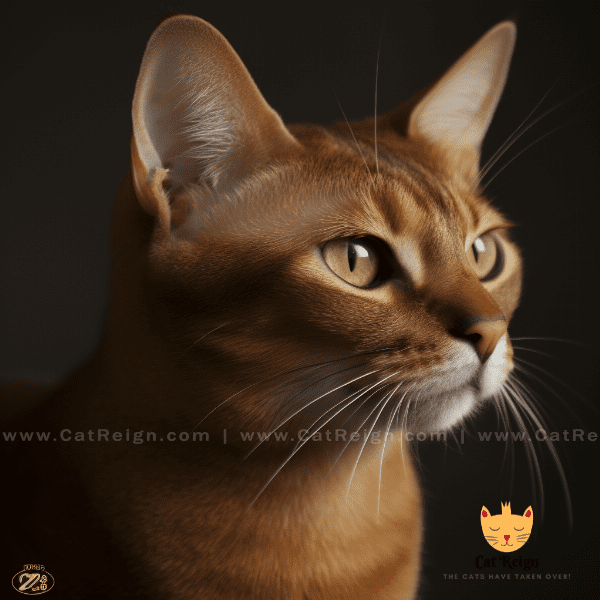
The Abyssinian Cat in Society and Culture
The Abyssinian cat has been a popular and beloved breed for centuries, and has made its mark on society and culture in a variety of ways. In this section, we’ll take a closer look at the Abyssinian cat’s role in society and culture.
Show Cats
Abyssinian cats are a popular breed in cat shows around the world. Show cats are judged based on their physical appearance, temperament, and overall health. Winning cats can earn titles and awards, and can also be used for breeding to improve the breed.
Advertising and Marketing
Abyssinian cats have been featured in advertising and marketing campaigns for a variety of products, from cat food to luxury goods. The breed’s distinctive appearance and charming personality make it a popular choice for companies looking to appeal to cat lovers.
Art and Literature
Abyssinian cats have been featured in art and literature for centuries. In paintings and sculptures, they are often depicted as elegant and regal creatures. In literature, they have been featured in a variety of books and poems, from the works of Mark Twain to the Cat Who… series by Lilian Jackson Braun.
Therapy Cats
Abyssinian cats have also been used as therapy animals in hospitals, nursing homes, and other healthcare facilities. The breed’s affectionate nature and friendly demeanor make them well-suited to providing comfort and companionship to people in need.
Social Media and Internet Fame
In recent years, Abyssinian cats have gained popularity on social media platforms, with several popular Instagram accounts dedicated to the breed. These accounts feature photos and videos of Abyssinian cats in various poses and situations, and have amassed large followings of cat lovers around the world.
In conclusion, the Abyssinian cat has made its mark on society and culture in a variety of ways, from cat shows to advertising campaigns to therapy work. With their distinctive appearance and charming personalities, Abyssinians are a breed that is sure to continue to capture the hearts and imaginations of people around the world.
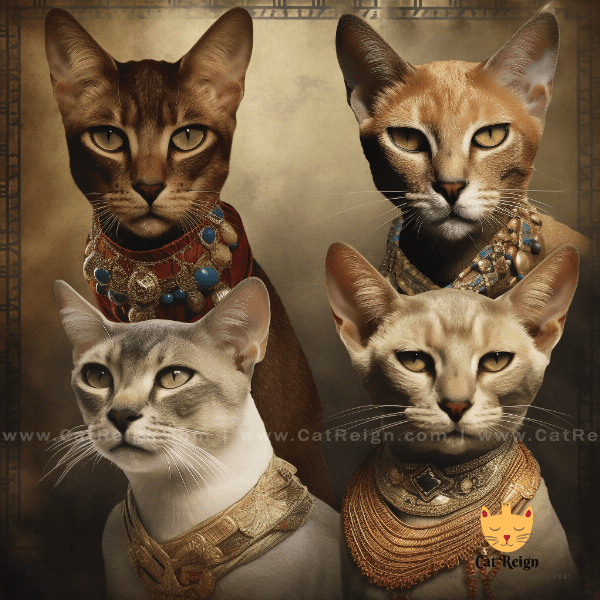
Interacting with Your Abyssinian Cat: Tips and Tricks
Interacting with your Abyssinian cat is an important part of building a strong and loving bond with your pet. In this section, we’ll provide some tips and tricks for interacting with your Abyssinian cat.
Playtime
Abyssinian cats are a highly active breed and need plenty of exercise and playtime to stay healthy and happy. Providing toys, climbing structures, and interactive playtime can help to satisfy their need for physical and mental stimulation.
Socialization
Socialization is important for all cats, and Abyssinian cats are no exception. Expose your cat to new people, places, and experiences to help them feel comfortable in a variety of situations. Introduce your cat to other pets slowly and under supervision to prevent conflicts.
Positive Reinforcement Training
Positive reinforcement training can be highly effective for training your Abyssinian cat. Use treats, praise, and rewards to encourage good behavior and discourage bad behavior. Avoid using punishment or negative reinforcement, which can harm your cat’s mental and emotional well-being.
Grooming
Grooming your Abyssinian cat is an important part of maintaining their health and well-being. Brush their fur regularly to remove loose hair and prevent matting. Trim their nails regularly to prevent them from becoming too long and causing discomfort.
Communication
Communication is key when interacting with your Abyssinian cat. Pay attention to their body language and vocalizations to understand their moods and needs. Use a calm and reassuring tone of voice when speaking to your cat, and avoid raising your voice or using aggressive body language.
In conclusion, interacting with your Abyssinian cat is an important part of building a strong and loving bond with your pet. By providing plenty of exercise and playtime, socialization, positive reinforcement training, grooming, and effective communication, you can ensure that your Abyssinian cat lives a happy and healthy life.
